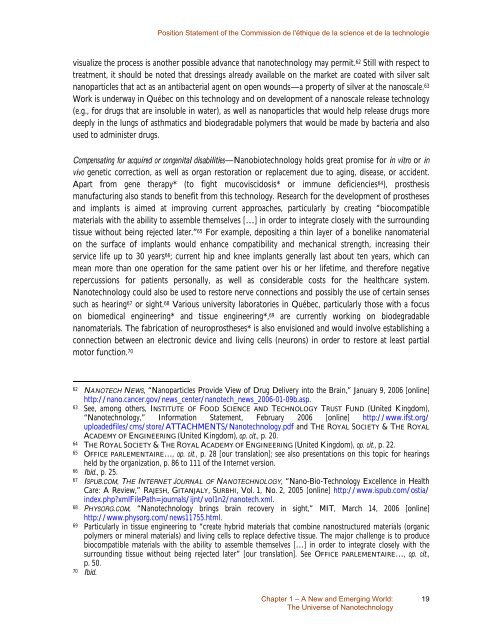A Basis for Action - Commission de l'éthique de la science et de la ...
A Basis for Action - Commission de l'éthique de la science et de la ...
A Basis for Action - Commission de l'éthique de la science et de la ...
You also want an ePaper? Increase the reach of your titles
YUMPU automatically turns print PDFs into web optimized ePapers that Google loves.
Position Statement of the <strong>Commission</strong> <strong>de</strong> l'éthique <strong>de</strong> <strong>la</strong> <strong>science</strong> <strong>et</strong> <strong>de</strong> <strong>la</strong> technologie<br />
visualize the process is another possible advance that nanotechnology may permit. 62 Still with respect to<br />
treatment, it should be noted that dressings already avai<strong>la</strong>ble on the mark<strong>et</strong> are coated with silver salt<br />
nanoparticles that act as an antibacterial agent on open wounds—a property of silver at the nanoscale. 63<br />
Work is un<strong>de</strong>rway in Québec on this technology and on <strong>de</strong>velopment of a nanoscale release technology<br />
(e.g., <strong>for</strong> drugs that are insoluble in water), as well as nanoparticles that would help release drugs more<br />
<strong>de</strong>eply in the lungs of asthmatics and bio<strong>de</strong>gradable polymers that would be ma<strong>de</strong> by bacteria and also<br />
used to administer drugs.<br />
Compensating <strong>for</strong> acquired or congenital disabilities—Nanobiotechnology holds great promise <strong>for</strong> in vitro or in<br />
vivo gen<strong>et</strong>ic correction, as well as organ restoration or rep<strong>la</strong>cement due to aging, disease, or acci<strong>de</strong>nt.<br />
Apart from gene therapy* (to fight mucoviscidosis* or immune <strong>de</strong>ficiencies 64 ), prosthesis<br />
manufacturing also stands to benefit from this technology. Research <strong>for</strong> the <strong>de</strong>velopment of prostheses<br />
and imp<strong>la</strong>nts is aimed at improving current approaches, particu<strong>la</strong>rly by creating “biocompatible<br />
materials with the ability to assemble themselves […] in or<strong>de</strong>r to integrate closely with the surrounding<br />
tissue without being rejected <strong>la</strong>ter.” 65 For example, <strong>de</strong>positing a thin <strong>la</strong>yer of a bonelike nanomaterial<br />
on the surface of imp<strong>la</strong>nts would enhance compatibility and mechanical strength, increasing their<br />
service life up to 30 years 66 ; current hip and knee imp<strong>la</strong>nts generally <strong>la</strong>st about ten years, which can<br />
mean more than one operation <strong>for</strong> the same patient over his or her lif<strong>et</strong>ime, and there<strong>for</strong>e negative<br />
repercussions <strong>for</strong> patients personally, as well as consi<strong>de</strong>rable costs <strong>for</strong> the healthcare system.<br />
Nanotechnology could also be used to restore nerve connections and possibly the use of certain senses<br />
such as hearing 67 or sight. 68 Various university <strong>la</strong>boratories in Québec, particu<strong>la</strong>rly those with a focus<br />
on biomedical engineering* and tissue engineering*, 69 are currently working on bio<strong>de</strong>gradable<br />
nanomaterials. The fabrication of neuroprostheses* is also envisioned and would involve establishing a<br />
connection b<strong>et</strong>ween an electronic <strong>de</strong>vice and living cells (neurons) in or<strong>de</strong>r to restore at least partial<br />
motor function. 70<br />
62 NANOTECH NEWS, “Nanoparticles Provi<strong>de</strong> View of Drug Delivery into the Brain,” January 9, 2006 [online]<br />
http://nano.cancer.gov/news_center/nanotech_news_2006-01-09b.asp.<br />
63 See, among others, INSTITUTE OF FOOD SCIENCE AND TECHNOLOGY TRUST FUND (United Kingdom),<br />
“Nanotechnology,” In<strong>for</strong>mation Statement, February 2006 [online] http://www.ifst.org/<br />
uploa<strong>de</strong>dfiles/cms/store/ATTACHMENTS/Nanotechnology.pdf and THE ROYAL SOCIETY & THE ROYAL<br />
ACADEMY OF ENGINEERING (United Kingdom), op. cit., p. 20.<br />
64 THE ROYAL SOCIETY & THE ROYAL ACADEMY OF ENGINEERING (United Kingdom), op. cit., p. 22.<br />
65 OFFICE PARLEMENTAIRE…, op. cit., p. 28 [our trans<strong>la</strong>tion]; see also presentations on this topic <strong>for</strong> hearings<br />
held by the organization, p. 86 to 111 of the Intern<strong>et</strong> version.<br />
66 Ibid., p. 25.<br />
67 ISPUB.COM, THE INTERNET JOURNAL OF NANOTECHNOLOGY, “Nano-Bio-Technology Excellence in Health<br />
Care: A Review,” RAJESH, GITANJALY, SURBHI, Vol. 1, No. 2, 2005 [online] http://www.ispub.com/ostia/<br />
in<strong>de</strong>x.php?xmlFilePath=journals/ijnt/vol1n2/nanotech.xml.<br />
68 PHYSORG.COM, “Nanotechnology brings brain recovery in sight,” MIT, March 14, 2006 [online]<br />
http://www.physorg.com/news11755.html.<br />
69 Particu<strong>la</strong>rly in tissue engineering to “create hybrid materials that combine nanostructured materials (organic<br />
polymers or mineral materials) and living cells to rep<strong>la</strong>ce <strong>de</strong>fective tissue. The major challenge is to produce<br />
biocompatible materials with the ability to assemble themselves […] in or<strong>de</strong>r to integrate closely with the<br />
surrounding tissue without being rejected <strong>la</strong>ter” [our trans<strong>la</strong>tion]. See OFFICE PARLEMENTAIRE…, op. cit.,<br />
p. 50.<br />
70 Ibid.<br />
Chapter 1 – A New and Emerging World: 19<br />
The Universe of Nanotechnology
















